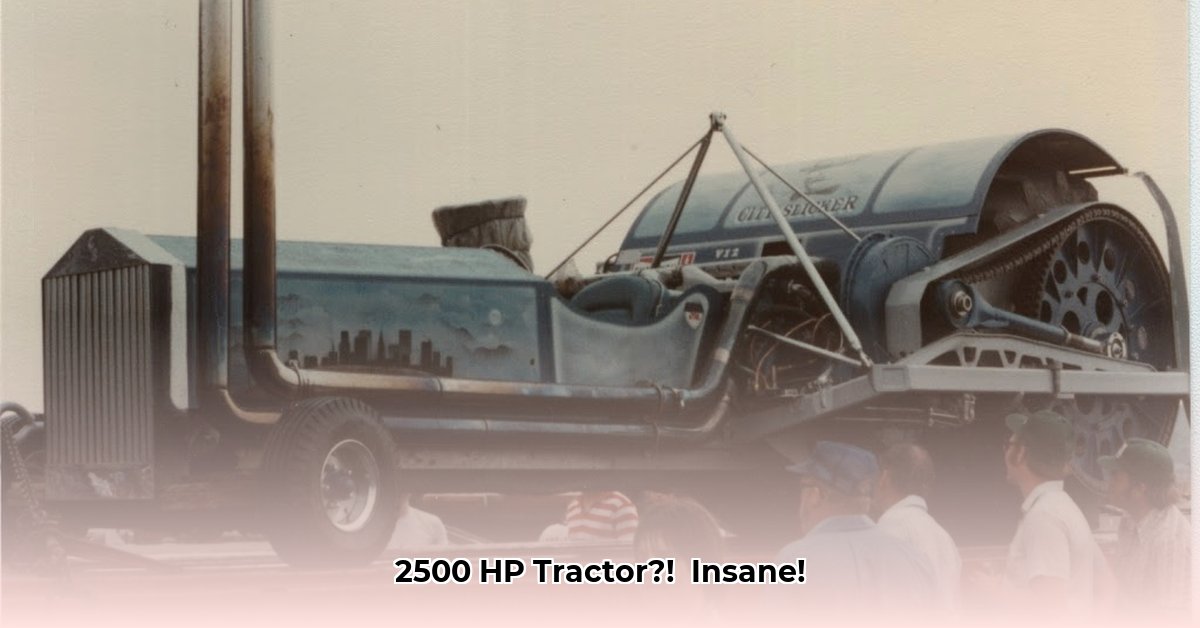
Forget your grandfather's trusty farmhand. Lee Pendleton's City Slicker redefined the tractor pulling world, not as a gentle tiller of soil, but as a 2500-horsepower beast—a roaring testament to audacious engineering and raw power. This wasn't a delicate restoration project; this was a monster, a machine that challenged conventional wisdom and left an indelible mark on competitive tractor pulling. For more on powerful tractors, check out this monster tractor.
Unleashing the Beast: Engine and Power
At the heart of this agricultural anomaly lay a triple-turbocharged Allison V12 engine—a powerplant more at home in a high-performance supercar than a pulling tractor. This wasn't some repurposed farm engine; this was a purpose-built powerhouse, fueled by alcohol and unleashing an estimated 2500 horsepower. To put that into perspective, that's enough to launch a small rocket. This wasn't about mere horsepower; it was about raw, untamed power, a force of nature harnessed for the sole purpose of dominating the competition. But how did Pendleton manage to control such a brute? The answer lies in his innovative design.
The Heart of the Matter: A Unique Design That Defied Convention
Pendleton's design was radical, a stark departure from traditional tractor engineering. He employed a sidewinder engine mount—a bold, unconventional choice that positioned the engine sideways. This unusual configuration, coupled with closely spaced rear tires, created an incredibly efficient power transfer system. He eschewed a standard driveshaft, opting instead for a massive chain drive system. Imagine a complex network of gears and chains, churning and groaning under the immense strain of that V12 – a marvel of mechanical engineering. Why this unusual design? The answer is simple: maximum traction.
Traction and Torque: Dominating the Competition
Tractor pulling isn't just about horsepower; it's about maximizing traction. The goal is to pull the heaviest weight the furthest distance, and tire slippage is the enemy. Pendleton's design choices were strategically aimed at minimizing this slippage. The V12's colossal torque, channeled through the close-coupled tires and the chain drive, acted as a perfectly synchronized team, delivering an almost unstoppable pulling force. This wasn't merely a machine; it was a carefully calibrated system, a symphony of engineering designed for one purpose: victory. But did it always win?
Isn't it fascinating how such innovative design choices were driven primarily by the need for traction in the brutal world of tractor pulling? The sheer power of the City Slicker is impressive, but it’s the ingenious engineering that truly makes it stand out.
Unanswered Questions and Documented Facts: A Legacy of Mystery and Marvel
While the City Slicker's power is legendary, precise figures from official competitions are surprisingly scarce. This lack of readily available data has led to much speculation among enthusiasts—a testament to the machine’s unique place in history. The long-term reliability of the electric throttle control system is another area shrouded in some mystery. However, the City Slicker’s impact on the tractor pulling world remains undisputed. It’s a machine that continues to generate discussion and awe among competitors and enthusiasts.
The City Slicker's Enduring Legacy: Inspiration and Innovation
The City Slicker was more than just a powerful machine; it was a bold declaration of what’s possible when imagination and engineering collide. Its audacious design and unparalleled power continue to inspire both awe and debate. It stands as a testament to unconventional thinking and a reminder that even the most utilitarian machinery can be a masterpiece of brute force and ingenious design. The tractor's legacy extends beyond nostalgia, inspiring new approaches to engineering and powertrain design.
Actionable Insights: Protecting the Past, Shaping the Future
The City Slicker's impact reaches far beyond its time. Its unconventional design and performance continue to influence modern engineering approaches. For enthusiasts, preserving its legacy is paramount. For engineers, studying its unique features provides valuable lessons and inspiration for future innovations.
Detailed Documentation: Comprehensive documentation of the City Slicker’s design and performance is crucial for preserving its legacy. This includes detailed photographs, schematics, and eyewitness accounts.
Preservation Efforts: Collaborative efforts between enthusiasts, museums, and historical societies are needed to ensure the physical preservation of remaining components or even a complete restoration effort.
Engineering Analysis: A thorough engineering analysis can reveal the intricacies of the City Slicker's design and inspire the development of new powertrain solutions for high-torque applications.
The City Slicker pulling tractor represents more than just a powerful machine; it's a symbol of human ingenuity and a testament to the potential of unconventional thinking. It remains a source of fascination, a reminder that limitations are often self-imposed. Its legacy endures, inspiring awe and igniting imaginations for generations to come.